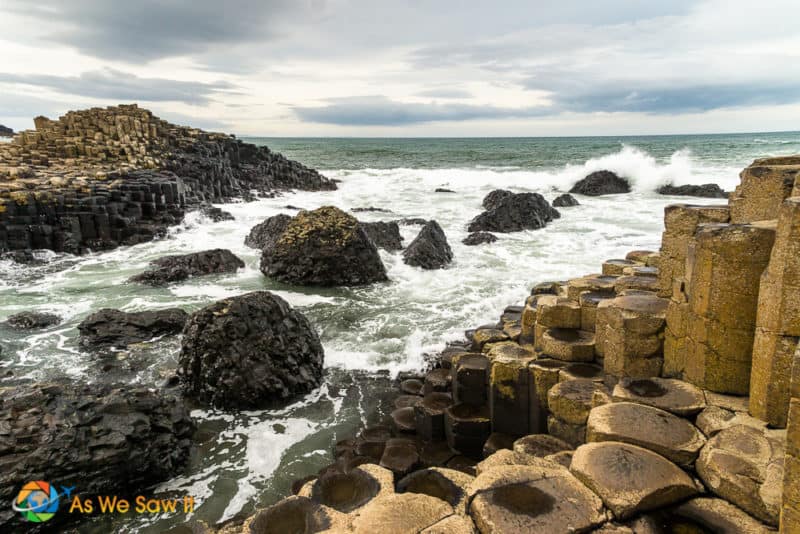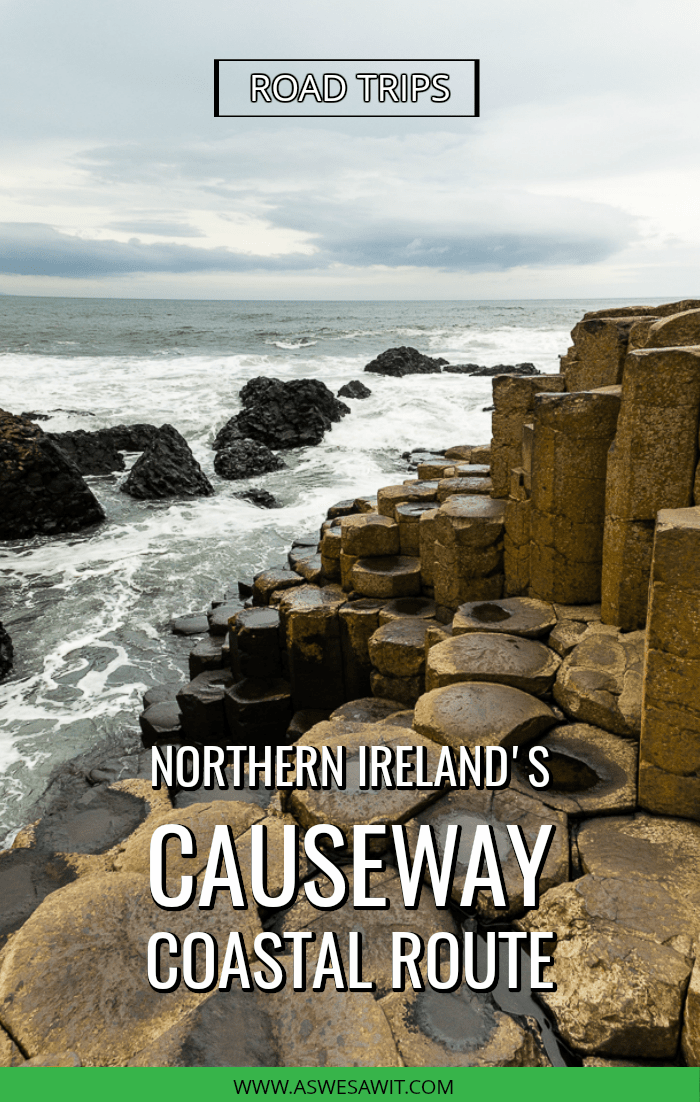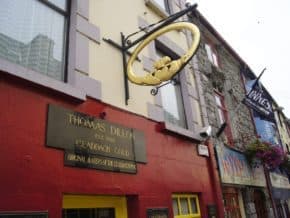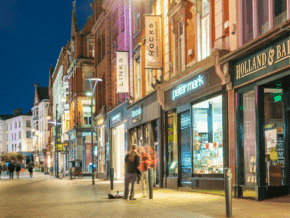Northern Ireland may be small in size, but it’s a giant among British destinations for natural beauty, historic sights and delicious food and drink. The best way to fully explore this country is by car, and a road trip on the Causeway Coastal Route is the ultimate way to do it.
The scenic drive on the A2 consistently ranks among the best scenic road trips in the world, even without considering that its attractions include the Giant's Causeway and the Carrick-a-Rede rope bridge!

3-Day Northern Ireland itinerary
You should plan to spend a minimum of three days to see the Antrim Coast (more if you're a Game of Thrones fan):
- Day 1: Leave Belfast (or Dublin) early, stop when you want, and spend the night in Bushmills or Portrush.
- Day 2: Backtrack to finish your sightseeing and continue on to Derry, where you'll spend the night.
- Day 3: Sightseeing in Derry and a leisurely drive back to Belfast or south into the Republic of Ireland.
Along the way, you will encounter many of Northern Ireland's best points of interest, which means that you'll probably have to make some tough decisions on what to leave out or what to see quickly.
Inspired? Pin this post and share it with your friends!

Causeway Coastal Route itinerary
This epic Northern Ireland road trip begins in Belfast and will take you to all the major attractions along Northern Ireland’s coast before it finally ends near the walled city center of Derry. Derry borders the Republic of Ireland (where they call the town Londonderry).
For the full Northern Ireland experience, you should couple driving the Antrim coast with 2-3 nights in Belfast. After all, Belfast is the country's capital and largest city, and there's a lot to see there. If you don't want to stay in Belfast, though, you can begin this itinerary in Dublin. Just keep in mind that the drive to Belfast from Dublin takes two hours, so you'll have to set off extra early on Day 1.
Day 1: Belfast to Bushmills or Portrush via A2 (Antrim Coast Road)

The Coastal Causeway was constructed between 1832 and 1842 by civil engineer William Bald. Instead of building the road inland, Bald envisioned a road at the foot of the cliffs instead. He wanted to avoid steep gradients, which could be quite dangerous.
The workers blasted parts of the cliffs and then used the fallen debris as the base for the coast road. It was a great engineering achievement for its day and made a great difference to the people of the Glens. Before the road was built, they sailed their goods across the sea to markets in Scotland because the sea crossing was easier than travel by land.
This part of the road is also relatively narrow and rather lightly used, which is great for a road trip. Let the sea breeze flow through your open windows and start cruising.
- From Belfast, we follow the A2 to Larne. This mid-sized town is the starting point of the Antrim Coast road. The road starts following the shoreline to the north.
Glens of Antrim
As we drive further, we’ll pass the Glens of Antrim. These nine valleys radiate from the Antrim Plateau to the coast.
Eventually, we arrive in Cushendall, a small coastal town. It lies at the meeting point of three of the Glens of Antrim: Glenaan, Glenballyemon, and Glencorp. Much of the historic character of this 19th-century settlement remains. In 1973 it was designated as the second Conservation Area in Northern Ireland and includes the (mostly intact) Irish Georgian buildings of the town’s four original streets.
ⓘ TIP: The Glens are an area of outstanding natural beauty. Great spot for hiking.
Torr Head
At Cushendall, the A2 is heading inland, but we keep following the coast by taking the spectacular Torr Road. This small road is winding and climbing its way up to Torr Head. From there you can easily see Scotland (which is only 16 miles away) on a sunny day.
- We keep following the Torr road and eventually rejoin the A2 at Ballyvoy.
Carrick-a-Rede Rope Bridge
- Leave the A2 at Ballycastle to take the B15 towards the famous Carrick-a-Rede Rope Bridge.

Take the exhilarating rope bridge challenge across to tiny Carrick-a-Rede island (a Site of Special Scientific Interest) and enjoy a truly cliff-top experience. Set amid unrivaled scenery on the North Antrim Coast, the 30-meter-deep and 20-meter-wide chasm is traversed by a rope bridge that was traditionally erected by salmon fishermen. It’s a bit sturdier these days, but there’s still only one way off the island: back across the swinging bridge!
This rope suspension bridge links the mainland to the tiny Carrick Island. The bridge spans twenty meters and is hanging thirty meters above the rocks below. The bridge is open all year round.
- After this little walk, continue along the B15. It will rejoin the A2 after a few miles.
Giant’s Causeway
- Further down the road, our next exit is the B147, also known as the Causeway Road.
The top attraction on any Northern Ireland itinerary, the Giant's Causeway is the center of an Area of Outstanding Beauty. It gave the coastal road its name and is Northern Ireland’s only World Heritage Site.
Famously steeped in myth and legend, this geological wonder is an area of about 40,000 interlocking basalt columns that were formed by a volcanic eruption. The tops of the columns form stepping stones that lead from a cliff and disappear under the sea, only to reappear again in Scotland. At some spots the columns are about 12 meters (39 ft) high and 28 meters thick.
Visiting the Giant's Causeway is a memorable experience. Begin your visit at the state-of-the-art Visitor Centre, then stroll down to the intriguing polygonal stones to search out distinctive formations such as the Camel, Wishing Chair, Granny, and Organ.
ⓘ TIP: If you want to visit the Giant's Causeway without paying for parking, you can either stay at the adjacent Causeway Hotel or park at nearby locations like Portballintrae or Dunseverick and walk to the site.
Bushmills
- We keep following the B147 and arrive in Bushmills.
This little village is home to the world’s oldest licensed distillery: The Old Bushmills Distillery. Take a guided tour through the heart of Ireland’s oldest working distillery, its original grant signed by King James I in 1608.
The finest Irish whiskeys have been produced here for over 400 years, using the same traditional methods and the water from the distillery’s own stream. Several of these whiskeys have won international awards.
Dunluce Castle
- After the whiskey tasting, we continue on the A2.

Just after leaving Bushmills, you can already see the Dunluce Castle ruins. The castle is surrounded by extremely steep drops on either side and is only accessible via a bridge connecting it to the mainland.
Over the years, Dunluce has been the site of tales of wailing banshees, smugglers, and tragic lovers. Perched dramatically on the cliffs of the North Antrim Coast, 100 ft/30 meters above the wild ocean, it was built around 1500 by the local MacQuillan family and later seized by the Scottish MacDonnell clan, who eventually established a small town here.
The castle may have resisted several sieges in the following years, but on a stormy night in 1639, dinner was interrupted as half of the kitchen fell into the sea during a monumental storm, taking the servants with it. At this, the Countess of Antrim promptly packed up the household and relocated inland, abandoning the castle to succumb to the relentless power of nature.
Nowadays, Dunluce Castle is open to visitors. There is a fee to explore the castle, but even if you choose not to go inside, it’s worth a stop just for the view.
💡 PRO TIP: Don't miss the Magheracross Viewing Point nearby. It offers amazing views of the stunning coastal scenery, from the Giant's Causeway to Portrush. It's a hidden delight along the coast road.
Where to Stay After Visiting the Giant's Causeway
After a day of driving the Antrim Coast and exploring, you’ve got some fantastic options for where to rest your head. While the Causeway Hotel is a good choice, we stayed at the Inn on the Coast in Portrush and thought it was comfortable, welcoming, and perfectly located for soaking up the coastal vibe. That said, if you're into whiskey, we'd recommend the Bushmills Inn instead. You can toast your day with a dram or two once you’ve parked for the night!
No matter where you choose to stay, tomorrow you’ll continue onward along the Causeway Coastal Route, with even more stunning views and hidden gems waiting for you.
Day 2: Bushmills/Portrush to Derry
Wherever you chose to spend last night, you can easily backtrack to catch more sights the following day, as we did. It's only eight miles from Portrush to the Giant's Causeway.
Portrush

While it's seen its best days, Portrush retains the atmosphere and architecture of a genteel seaside resort. Its peninsula is filled with lowbrow, family-oriented amusements, fun eateries, and B&Bs. Summertime fun-seekers promenade along the tiny harbor and tumble down to the sandy beaches, which extend in sweeping white crescents on either side.
Superficially, Portrush appears like any small British seaside resort, but its history and large population of young people give the town a little more personality. Along with the usual arcade amusements, you’ll find nightclubs, restaurants, summer theater productions in the town hall, and convivial pubs that attract customers all the way from Belfast.
- Portrush is also the end of the most scenic part of the Antrim Coast drive. After a little walk on the peninsula, we keep following the A2. The road turns more inland and heads for Derry.
Derry (aka Londonderry)

This city goes by two names, which makes it a bit of a controversy to some and a source of jokes to others. If you’re interested, you can learn more about the Derry~Londonderry name debate in this article. Let's just say that it is probably best for you to call it Derry while you're in Northern Ireland.
Derry is a perfectly preserved 17th-century walled city and is one of the finest walled cities in all of Europe. Aside from the walls, this historic city also boasts a beautiful setting and architecture, as well as a thriving arts and culture scene.
As Northern Ireland’s second-largest city, it’s also a great place to eat and drink, which was a huge plus for us!
ⓘ TIP: For more information and images, visit the official Visit Derry website.
Day 3: Derry-Londonderry to Belfast
Day 3 depends on your interests and obligations. You can spend more time touring Derry/Londonderry or take your time with a leisurely drive back to Belfast or Dublin.
- Driving from Derry/Londonderry to Dublin is 237 km (147 miles) and takes about 3 hours to drive.
- Driving from Derry/Londonderry to Belfast is 116 km (72 miles) and takes about 1.5 hours to drive.
Detours on the way back to Belfast or Dublin
If you have the time on your way back, take a detour to Northern Ireland’s Fermanagh Lakelands. Few people know that County Fermanagh is an outdoor lover's paradise thanks to its miles of lakes and rivers.

The Caldragh Cemetery on Boa Island
For something truly unusual, you'll want to detour to Boa Island. The Caldragh Cemetery contains two unique stone carvings. The larger one has faces on its two sides, which has made some call it a Janus figure, but all that they really know is that one is quite obviously male, and the other is clearly female. The smaller carving, “The Lustyman,” was brought to the cemetery from another location.
Some theorize that the statues are Celtic or from the British Iron Age, but the truth is that they are a mystery. No one is sure of their age or origin, or why they were carved.
- From Fermanagh Town, take the A32 North, then the B82 for about 10 kilometers, and then drive onto Boa Island (signposted). The Cemetery at Caldragh is also signposted on your left about 2 km down this road.

Renting a Car for the Antrim Coast
Sure, you could take a bus tour, but touring by car gives you the flexibility and independence to discover Northern Ireland’s true magic, off the beaten path, and in your own time.
We rented a car in Dublin for our Northern Ireland road trip. No one gave a second glance as we crossed the invisible border into Northern Ireland, and driving in a rental car presented no issues either.
You just need to remember that driving in Ireland requires some adjustment, especially if you are not used to driving on the left side and along very narrow country roads. Take your time and pull over often to breathe in the clean Irish air and savor the stunning vistas.
For more about driving in Ireland, check out this guide.
How much time does it take to drive the Causeway Coastal Route?
Driving the full Causeway Coastal Route—a 120-mile (185km) journey from Belfast to Derry—takes around 3 hours without stops. But honestly, that’s kind of missing the point. To truly enjoy the stunning views, historic sites, and charming villages, plan for 3 to 5 days. If you’re short on time, you can cover the route in 1 to 2 days, but you’ll still want to factor in stops for the best sights.
If your heart is set on the Giant's Causeway and nothing else, skip the hassle of renting a car and book a day trip from Belfast or Dublin. Easy peasy.
But what if you don't feel confident driving on the left-hand side of the road—or you just want to relax and soak up the views without worrying about navigation? There are tons of guided tours from Dublin that cover the best of the Causeway Coastal Route, including the Antrim Coast, Giant's Causeway, Belfast, and the Titanic Quarter. Some even throw in extras like Mount Stewart House and Gardens, the Mourne Mountains, and Game of Thrones filming locations. Bonus: your guide will bring the region to life with stories you'd never discover on your own.
Thoughts about our Northern Ireland itinerary
If you follow this itinerary, you will be assured of seeing the top sights of Northern Ireland and will undoubtedly fall in love with this stunning country just as we did. But please take our advice and don’t look at this road trip as just a checklist of must-sees.
As we said before, having a car gives you the opportunity to really explore and discover your own new favorite spots. If you see a side road, a village, a local pub, an overlook, or anything else that calls to you, do yourself a favor and answer that call. Some of the best memories are made when you get off the beaten path … and Northern Ireland is a perfect place to do it.
Northern Ireland trip planning resources
- The official Northern Ireland tourism website can be found here.
- Infinite Ireland has a guide to renting a car in Ireland.
- For more sightseeing, see our Northern Ireland photo gallery.
- See Northern Ireland from the air on Google Maps here. Zoom, scroll around, and explore!
Where to stay on the Antrim Coast
Depending on where you want to stop for the night, we can recommend:
- Causeway Hotel in Bushmills and
- Inn on the Coast in Portrush.
We stayed in Portrush.




The ocean views, castles and the Carrick-a-Rede Rope Bridge along Northern Ireland’s Causeway Coastal route are amazing – thank you.
You’re welcome! It’s a beautiful part of the planet, that’s for sure! Have you been?
The Causeway Coastal Route looks like a photographer’s dream, Linda. I always wanted to visit Ireland and you gave me some great idea about a scenic route. What time of the year do you think would be better? I mean weatherwise.
Hard to say, Anda. We were there in August and it was cold, windy and rainy, but it was sunny and cool during our October visit. So it’s hit-or-miss. If we had to choose a month, May and June would be our choice. After all, “April showers bring May flowers.”
Torr Head area is so magnificent. I could spend several days exploring around there.
Yeah, especially if you have a camera. (Trust us on that.)
It’s an amazing post! Ireland is high on my bucket list. Roadtripping through this country would be a dream come true. We (my husband and I) also did a road trip lately – from Mumbai (Maharashtra) to Raipur (Chhattisgarh) – so driving through two states of India was a fabulous experience.
Aren’t road trips fun? There are so many advantages, and our favorite is being able to stop for a photo anytime we want. (India is quite high on our bucket list, by the way.)
How scenic Linda. Gorgeous really. I love a good road trip. We are headed to New Zealand in 2 weeks. We have access to a car – from the women whom we’re house sitting for – and got our international driver’s permits from Triple A back in the USA before leaving. This means road trips throughout one of the most gorgeous lands on earth. Ireland is up there though. The Giants Causeway is jaw-dropping in its beauty.
Ryan
Super envious, Ryan, for everything about going to New Zealand except the super long flight. We have New Zealand on our short list too, because, you’re right, it’s got some of the most gorgeous views on the planet. That’s probably the biggest reason why they chose it for filming the Lord of the Rings Trilogy there.
At any rate, I’m looking forward to seeing your livestreams from there. How long will you stay? Will you make it to both North and South Islands?